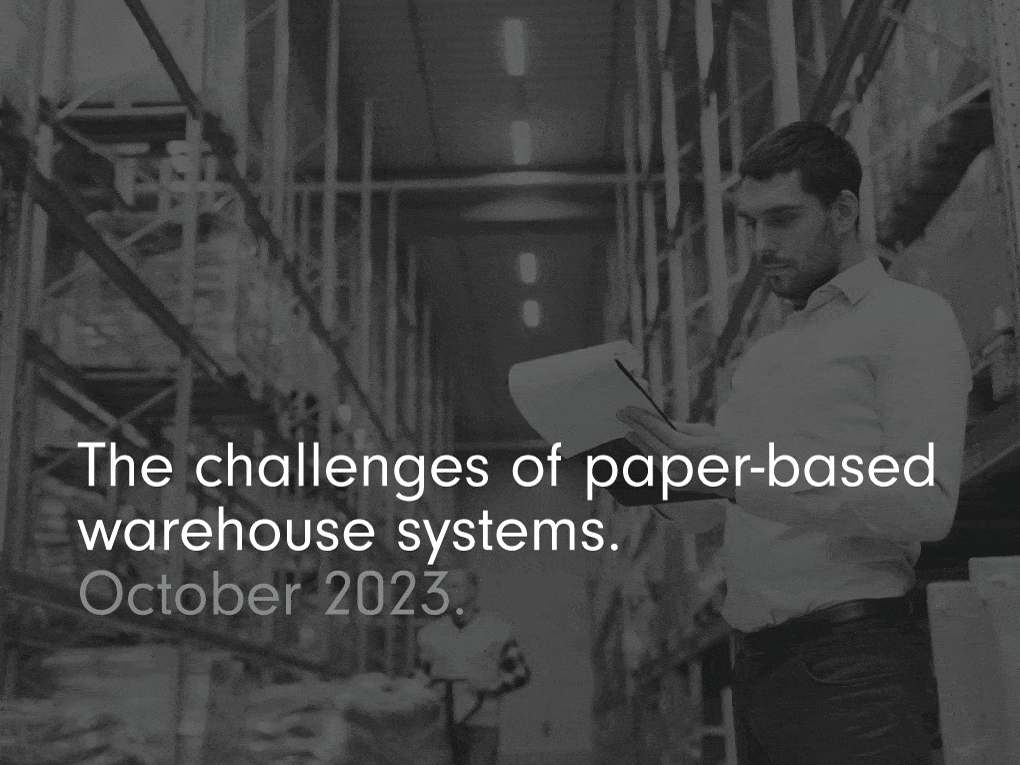
The challenges of paper-based warehouse systems.
Despite widespread digital transformation in distribution, it’s not unusual for companies to still be using paper-based systems. Not only are they inexpensive and simple to operate, but most companies will also typically begin with a paper-based system. These systems are familiar and practical and employees are reluctant to move away from them.
These sorts of paper-based warehousing processes are prone to errors, inefficiencies, delays and customer dissatisfaction. Small and medium sized warehouses tend to persist with paper due to fears about the costs and disruption of automation. The perceived challenges of transitioning to a new and unknown system, the time needed to retrain staff and the need for wholesale organisational change can mean they defer the decision to automate – or reject it completely.
However, using paper is beset with a number of critical problems and challenges that can negatively impact warehouse processes. Here are some of the common issues with paper-based warehousing.
Errors and inaccuracies.
Paper-based systems are prone to errors. The data may have been entered incorrectly in the first place. For example, the wrong stock location on a picking sheet would cause a picker to take an unnecessary detour when finding goods for an order.
Or it may be difficult to decipher someone’s handwriting, resulting in the wrong quantity of items being despatched.
Lost or misplaced documents can completely sabotage a pick run or an order, resulting in delays and frustration.
Inefficient stock management.
Lack of real-time data causes inefficiencies in stock management and incorrect order fulfilment.
A mistake where a worker fails to manually update inventory levels after making a pick can mean that stock levels are completely wrong. The company could then go on to sell stock that wasn’t available, leading to additional inconvenience and time needed to sort out the order with the customer.
Inaccurate inventory records that imply more stock is available can mean replacement stock is not ordered in time, causing a company to miss out on potential sales.
Time-consuming processes and delays.

Manual processes are slow and inefficient, especially in larger or more complex warehouses. This can lead to longer order processing times and slower delivery times.
Inefficient tracking and handling of goods also slows operations down. It makes it harder to find goods in the warehouse, for picking, replenishment and cycle counting.
Increased costs.
Manual, paper-based processes have an impact on costs. It can take a number of lengthy processes to carry out a few simple operations that an automated system can do far more quickly and without any intervention. With more staff undertaking complicated manual tasks, labour costs go up.
There are also additional costs involved with a paper-based system. It requires several printers, lots of paper, plus toner or ink cartridges – all of which are expensive.
There are lost opportunity costs to consider, too. Inaccurate inventory records can mean lost sales, with companies unable to fulfil orders.
Inability to scale and adapt.
Working manually with paper makes it difficult for a company to scale and adapt to new business demands.
While a paper-based system may work very smoothly for the smallest operations, there comes a time where it is untenable. This is different for each warehouse, but at some point, the system simply cannot match the demands of the operation when it comes to the number of SKUs or quantity of orders to be processed.
Excess paperwork.

Having a lot of paperwork to manage can be time-consuming. It becomes a laborious task for staff to print, manage and store it all. Precious space in the warehouse needs to be dedicated to storage and there are inefficiencies with accessing it. Even finding the right records can be slow and cause problems where indexing is not complete or accurate.
The excessive use of paper and ink carries an environmental cost. Systems dependent on paper not only consume valuable resources, but also contribute to increased carbon emissions. A paper-free operation is more efficient and is less environmentally detrimental.
Security risks.
Paper-based systems are more vulnerable to security risks. Paper is susceptible to damage – from water, fire, pests or simple wear and tear. Unlike digital systems that may have multiple backups, if a paper document is damaged, the information might be permanently lost.
Physical records can also be stolen, leading to potential data breaches or business interruptions. Equally, it is easier for anyone to access and read paper documents, risking sensitive information getting into the wrong hands.
Records kept on paper can be altered, tampered with or forged, which makes fraud more possible. Tracing actions or changes made on paper can be difficult too, often making it impossible to track any fraudulent activities or unauthorised access.
Customer dissatisfaction.

Customers want swift and accurate service when placing orders. However, paper-based systems often have slower order processing times and there can be fulfilment inaccuracies. This can frustrate customers, causing them to seek alternative suppliers.
Negative experiences may prompt customers to leave unfavourable online reviews, which can influence other customers’ perceptions. Over time, shortcomings like this can result in lost sales and difficulty attracting new business.
Compliance issues.
Companies that rely on manual systems may not be easily able to comply with regulations, such as those governing food safety and hazardous materials.
Manual record-keeping does not offer the robust traceability and rapid retrieval needed for compliance checks or audits. Delays and inaccuracies when using paper can make it difficult to validate that regulations have been adhered to, potentially exposing a company to penalties, legal ramifications and reputational damage.
Automating your operations with a warehouse management system (WMS).

As technology continues to advance and becomes more affordable and user-friendly, the shift from paper to digital is becoming more common. The long-term savings, efficiency and accuracy gains that businesses achieve with digital systems soon outweigh the initial challenges and costs of implementation.
A warehouse management system (WMS) can automate and streamline the manual and paper-based warehouse processes, reducing costs, improving accuracy, increasing productivity and enhancing customer service.
A WMS supports and optimises day-to-day warehouse operations and processes, including warehouse layout, staffing, receipt, picking, packing, replenishment and despatch.
